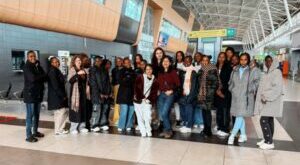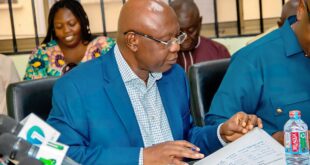Dozens of protesters in Beirut have entered the foreign ministry during a wider demonstration over Tuesday’s huge explosion that left at least 158 dead.
Several thousand people are on the streets in a planned protest, but there has been violence. Police fired tear gas at stone-throwing demonstrators.
Sounds of gunfire have also been heard from central Martyrs’ Square.
In a televised address, Prime Minister Hassan Diab said he would ask for early elections as a way out of the crisis.
“We can’t exit the country’s structural crisis without holding early parliamentary elections,” he said. The issue will be discussed in cabinet on Monday.
Many Lebanese are furious at the failure to prevent the explosion of over 2,000 tonnes of ammonium nitrate.
The material, which was being stored in a warehouse, had been seized from a ship six years ago but never moved. The government has promised to find those responsible.
The blast at the port devastated parts of the city and has deepened distrust of what many had already seen as an inept and corrupt political class. An anti-government protest movement erupted last October, fuelled by an economic crisis and a collapsing currency.
What is happening on the streets?
Crowds estimated at between 5,000 and 7,000 took to the streets in another day of protest, including a march from one of the most devastated areas near the port to Martyrs’ Square.
Skirmishes with the police began early on. Some protesters hurled rocks and sticks, and the police replied with tear gas and rubber bullets. There were flashpoints at barricades designed to prevent demonstrators reaching parliament.
But a group of several dozen chanting anti-government slogans and burning a portrait of President Michel Aoun entered the foreign ministry and called for all ministries to be occupied.
“We have it. It’s all ours. The police is outside the gate. They could not stop us,” one of the protesters, who identified herself as Rebecca, told the BBC World Service’s Newshour programme.
She said there were around 100 demonstrators inside the building, who had gained entry as it was already damaged by Tuesday’s blast. She said the protesters intended to stay as long as possible and occupy other ministries.

Police also confirmed to Reuters news agency that live ammunition had been fired in central Beirut, though it is not clear who fired.
Lebanese media quote the local Red Cross as saying that 110 people have been injured during the demonstrations – a third have been taken to hospital.
As the protests got under way, mock gallows were erected in Martyrs’ Square to hammer home the demonstrators’ view of the country’s political leaders
Apart from showing the city’s anger, the march was also meant to remember victims of the explosion, which injured 6,000, according to the latest update. Around 300,000 people are homeless.

How are other countries helping Lebanon?
Global leaders are scheduled to take part in a virtual donor conference on Sunday organised by French President Emmanuel Macron.
Mr Macron was mobbed in the streets by welcoming crowds calling for outside intervention as he visited Beirut earlier this week in the aftermath of the explosion.
France, the former colonial power, has close economic ties with Lebanon, which defaulted on its sovereign debt in March but has been unable to agree a reform programme with international lenders to obtain a bailout.
US President Donald Trump is among world leaders set to attend the virtual donor summit.

More on the explosion in Beirut
On Friday, UN agencies warned of a humanitarian crisis in Lebanon, including possible food shortages and an inability to continue to fight the Covid-19 pandemic.
Many countries have already offered aid, with the US announcing on Friday that it planned to immediately send $15m (£11.5m) worth of food and medicine.
The UK has released £5m of emergency aid and deployed a Royal Navy ship to Lebanon.
Prime Minister Boris Johnson spoke to President Aoun on Saturday and conveyed the UK’s “deepest sympathies to the Lebanese people”, Downing Street said.

What more do we know of the victims?
The Syrian embassy says 43 Syrians were among those killed as a result of the blast. Reports suggest some were port workers.
Lebanon hosts more than a million Syrians following an influx of migrants sparked by the long conflict in Syria.
Another casualty was the wife of the Netherlands ambassador. Hedwig Waltmans-Molier died from injuries sustained in the blast, the Netherlands foreign ministry said.
A two-year-old Australian boy, Isaac Oehlers, was also killed, Australian media say.
The Lebanese authorities now say 21 people are still missing.
What is happening with the investigation?
Lebanon’s president and prime minister have said 2,750 tonnes of ammonium nitrate – which is commonly employed as a fertiliser but can also be used to create an explosive – had been stored in a warehouse at the port without any safety precautions since 2014, when it was unloaded from an impounded cargo ship, the MV Rhosus.
The decision to keep so much explosive material in a warehouse near the city centre has been met with disbelief by many Lebanese.
On Wednesday, Mr Aoun promised a transparent investigation by Lebanese authorities and to “hold those responsible and those who were negligent accountable, and serve them the most severe punishment”.
However, calls for an international investigation have grown since then.
The president ruled out such a move on Friday, saying: “The goal behind calls for an international investigation into the port issue is to dilute the truth.”


President Aoun also said the government-backed inquiry was looking into three possibilities: negligence, accident or what he called “external interference through a rocket or bomb or other act”.
Officials have said the explosion appears to have been triggered by a fire and there has been no evidence so far of the third possibility mentioned by Mr Aoun.
Twenty-one people have been arrested – among them Badri Daher, the director-general of Lebanon’s Customs Authority.
The Iran-backed Hezbollah movement, which supports the power-sharing government, meanwhile denied any involvement in the blast, insisting that his group did not control the port and that it had stored no weapons or ammunition there.
Hezbollah leader Hassan Nasrallah declared in a speech: “Not a weapons cache, not a missile factory, not a single missile, not a single rifle, not a single bomb, not a bullet, not nitrates. Nothing at all. Not now, not in the past.”
BBC.COM
 Home Of Ghana News Ghana News, Entertainment And More
Home Of Ghana News Ghana News, Entertainment And More







